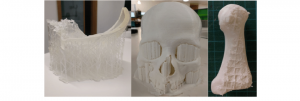Reflections
- How to do inquiry
- Try not to focus on subjects – focus on “the thing” that they want to learn about
- If you focus on the thing that they want to learn about, like trains for a child in grade 1 who’s really into trains, then you build on working in curricular competencies from there. Focus on the interest they have and build on math, english, social studies, etc. skills from there
- Distributed learning classrooms
- Face to face
- Layout of face to face classrooms is often limiting in terms of facilitating dynamic and collaborative learning
- Online courses:
- Mixed feelings about whether or not we like it – some people find the self-directed aspect really works for them, others not so much.
- A lot of teachers who are teaching online courses are thrown into the job and don’t necessarily feel passionate about teaching online courses
- Some teachers use online platforms with no collaboration and face to face meetings/discussions
- Synchronous online classrooms bring in discussion and collaboration
- Multiaccess learning
- Multi access form classrooms – allows for people who want to/can come into the room as well as those who want to participate online.
- Barriers to physically attending schools that are important to be aware of
- Remote learners
- Time
- Travel
- Physical access
- Face to face
How does integrating technology affect students by Anna, Sydney and Kathleen
- 3 Questions to consider when integrating screen time into your classroom:
- Is it appropriate
- Is it meaningful?
- Is it empowering?
3D Design and Print by Nick and Jamie
- Prosthetics: how 3D printing can be used
- Many people need them around the world
- They are very expensive – $100 000
- Often hard to find prosthetics that work for people
- 3D printing makes getting a prosthetic more affordable and accessible
- What is 3D printing
- Digital model is rendered into a physical 3D object by adding one layer of material at a time
- This model is sliced by the printer’s software into thin, 2D layers then into a set of instructions in machine language (G-code) for the printer to execute
- Depending on the size of the part and type of printer, a print usually takes about 4 to 18 hours to complete
- 3D printed parts
- Platforms: Software and Hardware
- 3d Modeling software sites
- Tinkercad
- Rhinoceros
- Fusion 360
- Onshape
- Predesigned model sites (industrial models)
- Thingiverse
- Hardware
- 3D printer
- Filament
- Computer
- 3D print software
- If you wanted to get 3D printer set up at home (starting from scratch) it would cost you about $3500
- 3d Modeling software sites
- Materials
- PVA
- Polyvinyl alcohol
- Dissolves in water
- No ugly marks left on the print after the support material is removed
- Can require special chemicals to dissolve
- TPU
- Thermoplastic polyurethane
- Flexible filament (elastic polymer)
- Slow to print – rarely higher than 30mm per second
- PLA
- Polyactic acid
- Used at UVic
- Biodegradable – breaks down in 3-6 months
- PVA
- Pros
- 3D printing allows easy fabrications of complex shapes, many of which cannot be produced by any other manufacturing method
- Essentially no start up costs for us as students because everything is accessible on campus to us
- Allows for easy customisation – just change 3D print model
- Less waste production
- Support material is broken down and reused
- Cons
- Temperature of the filament from the printing process is above 200 d C
- Time for a completed model to print can range dramatically
- Leaning curve for the user
- Techniques
- Supporting
- Structures are not a part of the model – usually a light filament that are later broken off
- Supporting

Leave a Reply